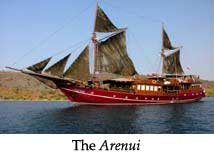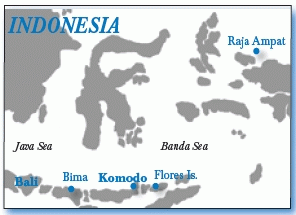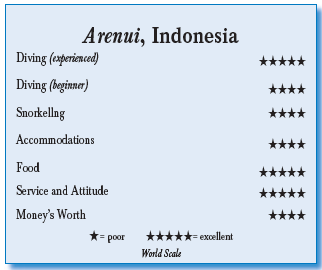Arenui, Komodo Island, IndonesiaContents of this Issue: Arenui, Komodo Island, Indonesia A Mouthpiece to Prevent Diverís Mouth Lionís Dive & Beach Resort, Curacao Which Dive Computers for High Altitude Diving? Australia, Grand Cayman, Philippines . . . The Nautilus Lifeline Finally Ships Scuba Snobsí Guide to Dive Etiquette The Death of Steve Irwin, Redux Nobody Wants a Bursting Scuba Hose Editorial Office: Ben Davison Publisher and Editor Undercurrent 3020 Bridgeway, Suite 102 Sausalito, CA 94965 here there be dragons - - and fish big and tiny from the November, 2011 issue of Undercurrent
Dear Fellow Diver, Discovering new dive destinations has redefined my scuba diving. Traveling aboard the boutique vessel Arenui, a typical wooden phinisi, my September trip to Indonesia provided muck diving, strong currents that required reef hooks, bottomless reef walls and best of all, amazing new sightings daily. Like the aptly named Bobbitt worm, which looks like the infamous member hacked off by the equally infamous Lorene Bobbitt. You remember that, right? Departing Benoa Harbor in Denpasar, Bali, we rocked and rolled overnight in moderately rough seas and windy conditions as we headed for Lombok Island. I think all of the 12 divers aboard heeded the predeparture warning: if you are weak of stomach, pop a pill. The next morning, we dived on the east side of Lombok near the island of Gili Lawang. Disappointed in seeing blasted reefs, we moved nearby to make an exploratory muck dive. Usually observed with his head protruding out of the sand, a snake eel slithered along. I spotted a school of striped catfish, crinoid shrimp, a spiny devilfish, a cockatoo waspfish, a hairy angler (i.e., a frogfish), and ghost and Halameda pipefish. A carrier crab toted a piece of wood on its shell. Even so, a mediocre dive, given what was to come.
The unconventional dive deck on the pitched bow, where wetsuits were hung to dry, would be cramped with a full load of divers. After disembarking from tenders at the stern (there was a hot water shower there), one had to stroll through the salon. It worked, because the staff mopped constantly (which is one reason why they need 22 staffers). The cheerful crew always ensured gear was clean, dry, and ready to go. They transported it to and from the tenders and provided a clean towel after each dive. Their two basic tenders have wooden seats with spaces for tanks. Rides were 10 minutes or less. (During one ride, Gerry cannibalized another regulator to repair my leaking ancient Mark V before we reached the dive site.) If the current was strong, we made a direct descent; if too strong, we went to another site. Like a drill sergeant, divemaster Tobi would command: "Mask on, air in, 1, 2, 3, go!" and we backrolled. After the drift, the tenders picked us up quickly and we climbed back in via a metal ladder with thin and uneven rungs -- it took a hefty leg swing to complete maneuver. The water ranged between 71 and 82 degrees (air temperatures were in the high 70s). I always wore a 5-mm suit and added a skin or two, plus a hooded lined vest. Maximum dive time was 70 minutes. While there was a flexible buddy system, I stuck with Gerry like a leech, as he had an eye for everything.
After a direct descent in a two-plus knot current at Crystal Rock, I made good use of my reef hook to admire a three-foot-long Napoleon wrasse, big-eye trevally, surgeonfish, schools of fusiliers and several white-tips, one of which was pregnant. At Castle Rock, I watched surgeons chased by trevally with sharks following. The fish were so thick I thought the sun had been eclipsed. Our next stop was Rinca Island's Cannibal Rock. Considered one of the world's top 10 dive sites, it was discovered by the late Larry Smith, an Indonesia dive icon. In chilly 72-degree water, I found a giant pink frogfish and some red sea apples, a species of sea cucumber which were closed while others were open and feeding. A yellow pygmy seahorse clung to a sea fan. Afterwards, while some divers kayaked, I indulged myself in a so-so massage on the top deck. We ate when we weren't diving or sleeping. A "small" breakfast included fruit, yogurt and cereal, followed by a "big" breakfast (including perfectly poached eggs and crisp bacon) after the first 8 a.m. dive. Lunch buffets included homemade soup, entrees of fish, chicken, pork, and pasta, plus fresh vegetables and fruit, noodles and rice. The third dive, around 3 p.m., was followed by a snack of either pizza, fish sticks, tropical fruit, cookies, even a fresh cake. Dinner was a four-course, sit-down meal that included a salad, homemade soup, a choice of two entrees, and a homemade dessert served with ice cream. To accommodate night divers, two dinner times were offered. There was a full honor bar, and a fine but pricey wine ($30 to more than $100). Strong Balinese, finely ground coffee was always available; espresso was an additional $2.50 (seems chintzy given the Sultan's fortune for this voyage). While food was generally excellent, the Mexican fare flopped. The only fresh fish served was the first night's tuna sashimi. (The explanation was that we were diving in a national park where fishing is restricted, and I'm all for leaving fish on the reefs we visited. But they did offer frozen tuna, red snapper, or butterfish and honored dietary requests.) Dinner was served either on the top deck or in the salon, where there were two tables for eight and a couple of cozy booths. The salon has several lounge areas, a camera charging station, two Mac computers loaded with Adobe Photoshop CS5, and two flat screen TVs, used for PowerPoint briefings for each dive. One screen displayed a virtual GPS of our route. I often kicked back on the top deck in a comfortable canvas deck lounge. Before I departed, Ben Davison forwarded me comments from an Undercurrent subscriber who had been on the boat a few weeks before. She had a few complaints and he asked me to verify them. Yes, as it turned out, several cabins had occasional roach sightings. However, I'm little bothered because I expect a few in the tropics (so I didn't keep food in my cabin, as Debbie cautioned). Yes, the boat creaked and doors rattled. I braced my main deck cabin's creaking door with a towel, and locked the louvered folding bathroom door to prevent it from banging. The Garuda cabin had exhaust fumes, but they subsided after a couple days. At the introductory briefing, Debbie cautioned, "Our wooden decks are like banana peels. Take the gray rubber-mat road. We don't want you to slip." Yes, the decks were particularly slick when wet, so I always wore my Tevas. (I'm too old to fall down. Aren't we all?) Steps throughout the boat are high and uneven. Handholds seem randomly placed. Debbie didn't ignore problems, and in fact encouraged us to speak up. "It is a phinisi. We have three engineers on board. We don't want you to complain about something that we will fix for the next group." When we moved at night, the creaking in his lower deck cabin bothered one diver, so Debbie had him sleep in an upper deck cabin. South Africans Leon and Claudia Pellarini-Joubert, professional underwater photographers who live in Papua New Guinea, coached us gratis in Photoshop CS5 (see their work at www.bittenbysharks.com ). While we all had cameras, only one American had an SLR. Our congenial group -- including two French Canadians, three South Africans, and three Americans -- ranged in age from the 30s to nearly 70. And none was cranky or a complainer. One American had biceps that would rival anyone's. To help me get my wetsuit over my widest part, he gently picked me up off the deck. Our fourth daily dive was after sundown. While we all participated in one or more night dives, there were only two regulars. At Torpedo, off Rinca Island, a hairy frogfish lay camouflaged in soft coral. There were skeleton shrimp, a coconut octopus, even the Bobbitt worm. The bone-chilling 71-degree water limited my dive to 40 minutes. With so many liveaboards plying these waters, there is an unwritten rule that the first boat at a site has priority and others do not put their divers in the water. But when one boat ignored our presence at Cannibal Rock, we made an exploratory dive in Crinoid Canyon, returning when the other divers left. Here, I saw two mimic octopuses that scurried along the sand, not stopping to contort themselves into the shapes of one of the many critters they could amazingly mimic. In Manta Alley, on the south side of Komodo Island, 10 large mantas appeared on each of two dives but quickly zipped away. At Pink Beach, colorful mandarin fish engaged in their mating ritual, swirled in thick fields of staghorn coral. Leaving the marine park, we motored to Takat Makassar Channel between Flores and Komodo. Flying in the current, I buzzed up and past a dozen mantas, hoping they would dodge me. I was out of steerage control and I'm sure they knew. What a thrill! Discovery Bay, along Flores Island, is a 19-hour steam from the island of Sabalon. Indonesian fishermen continue to blast fish and destroy reefs. Nevertheless, it's a muck divers' paradise, though one touch from a fin created a black sandstorm cloud mixed with dead leaves and twigs. Here, I saw many new critters: still unplaced in the genus octopus, the mosaic is cream colored with spotted arms. It has a unique darkish mosaic pattern and an extended mantle. My trip ended at the port of Maumere on Flores Island, with not the best of conclusive dives, but I had so many great ones, why quibble? After our final dinner on the top deck at the "Sky" restaurant, our crew performed a "sing-sing." Dancing and singing, some in Papua headdress, they embraced us goodbye. New friends, great diving, beautiful weather, lots of new sightings, Komodo dragons, excellent food, great service and luxury. The boat amenities, despite some issues, were great. Though it was a pricey 12 days, I left satisfied, knowing that even at the price, I surely didn't get my pocket picked. -- D.L.
|

I want to get all the stories! Tell me how I can become an Undercurrent Online Member and get online access to all the articles of Undercurrent as well as thousands of first hand reports on dive operations world-wide
| Home | Online Members Area | My Account |
Login
|
Join
|
| Travel Index |
Dive Resort & Liveaboard Reviews
|
Featured Reports
|
Recent
Issues
|
Back Issues
|
|
Dive Gear
Index
|
Health/Safety Index
|
Environment & Misc.
Index
|
Seasonal Planner
|
Blogs
|
Free Articles
|
Book Picks
|
News
|
|
Special Offers
|
RSS
|
FAQ
|
About Us
|
Contact Us
|
Links
|
3020 Bridgeway, Ste 102, Sausalito, Ca 94965
All rights reserved.

 Our next stop was near the city of Bima on the northern
coast of Sumbawa. The
site of Tanyung Sai had
great visibility, however,
despite being told
not to stir up the fine
black sand, too many
sand kickers -- experienced
divers, mind
you -- ruined photos
by unleashing floating
silt. Still, the critters
were interesting.
A coconut octopus held
a crab in its beak, an orange frogfish was blind in one eye, a pinkie-
size cuttlefish squirted away in a flash.
A rare Melibe nudi, appearing thin and limp,
looked like floating tissue paper. Gerry, the
divemaster, pointed out unhatched cuttlefish
eggs, and a pipefish carrying her own eggs. On
a clownfish, he noted two speck-like microscopic-
size isopods that suck the clown's blood.
Our next stop was near the city of Bima on the northern
coast of Sumbawa. The
site of Tanyung Sai had
great visibility, however,
despite being told
not to stir up the fine
black sand, too many
sand kickers -- experienced
divers, mind
you -- ruined photos
by unleashing floating
silt. Still, the critters
were interesting.
A coconut octopus held
a crab in its beak, an orange frogfish was blind in one eye, a pinkie-
size cuttlefish squirted away in a flash.
A rare Melibe nudi, appearing thin and limp,
looked like floating tissue paper. Gerry, the
divemaster, pointed out unhatched cuttlefish
eggs, and a pipefish carrying her own eggs. On
a clownfish, he noted two speck-like microscopic-
size isopods that suck the clown's blood. The upscale 142-foot Arenui (Indonesian
for "small wave"), was built from mostly indigenous
recycled wood and began operating in
2009. With space for 16 divers, she carried
a crew of 22, including two cruise directors,
Debbie Benton from the U.K. and Geraldo (Gerry)
Arriaga from Mexico City, an engaged and engaging
couple. Their management is all about comfort and service.(At $5,000 plus for 12
days, not to mention airfare, it darn well better be.) Below decks are six cabins;
four master suites are on the main deck. The beautiful cabins have batiks, Oceanic and
Balinese artwork, copper light fixtures and brass hanging hooks. Carved wooden vanities
had round counter tops and marble sinks with brass faucets. While there were no
closets, drawer and cabinet space was ample.In mosaic-tiled bathrooms, waterfall showers
drain on the wood-slatted floors before reaching the toilet.(Toilet paper goes in a
garbage can alongside.)
The upscale 142-foot Arenui (Indonesian
for "small wave"), was built from mostly indigenous
recycled wood and began operating in
2009. With space for 16 divers, she carried
a crew of 22, including two cruise directors,
Debbie Benton from the U.K. and Geraldo (Gerry)
Arriaga from Mexico City, an engaged and engaging
couple. Their management is all about comfort and service.(At $5,000 plus for 12
days, not to mention airfare, it darn well better be.) Below decks are six cabins;
four master suites are on the main deck. The beautiful cabins have batiks, Oceanic and
Balinese artwork, copper light fixtures and brass hanging hooks. Carved wooden vanities
had round counter tops and marble sinks with brass faucets. While there were no
closets, drawer and cabinet space was ample.In mosaic-tiled bathrooms, waterfall showers
drain on the wood-slatted floors before reaching the toilet.(Toilet paper goes in a
garbage can alongside.) At Hot Rocks, a site at Sangeang
Volcano, warm sulfuric bubbles trickled up
from the sand. I admired a pair of cowries,
covered with their black mantles,
resting in a sponge. A large black lionfish
carried eggs on her spine, and a
green turtle gnawed on a sponge. (Gerry had
heard it gives them a "buzz." How would
anyone know?) Glassy eyes rose in columns.
Thousands of crinoids and orange anthias
formed rainbows. A yellow and black ribbon
eel burrowed in the sand under table coral.
When I hit a raging current that created
a black sand storm, I kicked hard to rest
behind a beautiful reef covered with every
imaginable soft and hard coral. In the
shallows, I spied a spiny devilfish, a variety of nudibranchs, and several blue painted
lobsters.
At Hot Rocks, a site at Sangeang
Volcano, warm sulfuric bubbles trickled up
from the sand. I admired a pair of cowries,
covered with their black mantles,
resting in a sponge. A large black lionfish
carried eggs on her spine, and a
green turtle gnawed on a sponge. (Gerry had
heard it gives them a "buzz." How would
anyone know?) Glassy eyes rose in columns.
Thousands of crinoids and orange anthias
formed rainbows. A yellow and black ribbon
eel burrowed in the sand under table coral.
When I hit a raging current that created
a black sand storm, I kicked hard to rest
behind a beautiful reef covered with every
imaginable soft and hard coral. In the
shallows, I spied a spiny devilfish, a variety of nudibranchs, and several blue painted
lobsters. Divers Compass: Depending on the season, the Arenui travels throughout Indonesia for varied periods; My 12-day Komodo voyage cost $5,200, not including alcohol or espresso, plus Nitrox for $180, and one complimentary 30-minute massage . . . My trip required a night in Bali on both ends . . . There is no internet access, and the satellite phone costs $5 per minute . . . Batavia Air charges for excess baggage . . . To get around, you need Indonesian rupiah, not American dollars . . . Maumere is predominantly Catholic, but we could hear the Call to Prayer. . . Having an afternoon departure from Maumere, Arenui arranged a complimentary tour to see a small museum and a village, which is better than sitting at the airport . . . Website:
Divers Compass: Depending on the season, the Arenui travels throughout Indonesia for varied periods; My 12-day Komodo voyage cost $5,200, not including alcohol or espresso, plus Nitrox for $180, and one complimentary 30-minute massage . . . My trip required a night in Bali on both ends . . . There is no internet access, and the satellite phone costs $5 per minute . . . Batavia Air charges for excess baggage . . . To get around, you need Indonesian rupiah, not American dollars . . . Maumere is predominantly Catholic, but we could hear the Call to Prayer. . . Having an afternoon departure from Maumere, Arenui arranged a complimentary tour to see a small museum and a village, which is better than sitting at the airport . . . Website: 